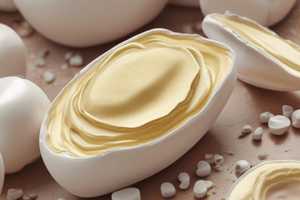Podcast
Questions and Answers
What are the advantages of using a shellac base plate in denture base construction?
What are the advantages of using a shellac base plate in denture base construction?
The advantages of using a shellac base plate include being inexpensive, easily and quickly adapted.
Identify two disadvantages of auto polymerizing resin used in denture bases.
Identify two disadvantages of auto polymerizing resin used in denture bases.
Two disadvantages of auto polymerizing resin are high polymerization shrinkage and brittleness.
How does a processed acrylic resin contribute to the durability of a denture base?
How does a processed acrylic resin contribute to the durability of a denture base?
Processed acrylic resin contributes to durability as it results in a permanent denture base that is stable.
Why is the orientation relation important when using occlusal rims?
Why is the orientation relation important when using occlusal rims?
What properties make cast alloys desirable in denture base construction despite their higher cost?
What properties make cast alloys desirable in denture base construction despite their higher cost?
What are the main advantages of including beading and boxing in the construction of a denture master cast?
What are the main advantages of including beading and boxing in the construction of a denture master cast?
How thick should the base of the cast be, and what are the recommended dimensions for the land and depth of the vestibule?
How thick should the base of the cast be, and what are the recommended dimensions for the land and depth of the vestibule?
What technique is employed to create the posterior palatal seal (PPS), and what are its essential dimensions?
What technique is employed to create the posterior palatal seal (PPS), and what are its essential dimensions?
What is the ratio of dental stone to water recommended for pouring casts, and why is it important for the cast's quality?
What is the ratio of dental stone to water recommended for pouring casts, and why is it important for the cast's quality?
Describe how the anterior border of the posterior palatal seal is shaped regarding its depth transition.
Describe how the anterior border of the posterior palatal seal is shaped regarding its depth transition.
Flashcards are hidden until you start studying
Study Notes
Materials for Record Bases
- Shellac base plate: inexpensive, easily adapted, but tends to warp and is brittle
- Auto polymerizing resin: easy to manipulate, but has high polymerization shrinkage
- Light cures resin (vlc): exhibits flow at mouth shape and temperature, slightly slow strength compared with autopolymerizing resin
- Wax: easier to use during setting of teeth with restricted inter arch distance, setting is easier if you don’t have space, but is brittle, lacks rigidity and stability, can be easily distorted
- Processed acrylic resin: permanent denture base, stable, but might get distorted during double processing when not properly handled
- Cast Alloys: rigid, accurate and dimensionally stable, thinner with thermal productivity, but more expensive, time consuming, adds more weight
Adaptation of Record Bases
- Shellac base plate: available as preformed shape for max and man arches.
- Auto polymerizing resin: polymer and monomer pink resin with fibers.
- Processed acrylic resin: makes use of heat cured resin in slow curing.
Uses of Occlusal Rims
- Wax forms are used to establish the outline of the base for trimmed casts and to preserve desired details.
Advantages of Beading and Boxing
- Superior hardness of cast surface.
- Provides land area.
- Preserves border of the impression.
- Minimizes trimming.
Pouring of Casts
- Once beading and boxing is done, pour cast with dental stone (100 gm of stone to 28-31 ml of water) and allow it to set about an hour.
- Tongue space on the mandibular casts should be trimmed flat.
Post Damming of the Master Cast
- Beading along the posterior palatal seal area.
- Do grooving on the cast along the PPS area which connects from the hamular notch, passing the vibrating line.
Functions of Post Damming
- To provide tissue displacement for peripheral seal area.
Master Cast/ Working Cast
- Replica of the denture bearing areas and other structures of the oral cavity needed to fabricate a dental prosthesis.
Refractory Cast
- Treatment: Boxing and Basing.
- Basing requirements: equal thickness, no U-shaped cast for the lower.
Beading
- The portion of a dental cast that extend beyond the impressions replica surface laterally.
Boxing an Impression
- The enclosure (box) of an impression to produce the desired size and form of the base.
Retrieving of Casts
- After the cast has set, place the tray with cast in hot water to soften the low fusing compound and carefully separate the cast from the impression.
Trimming the Master Cast
- Procedure of reducing the size altering the shape of the cast and retaining important structures behind.
- Requirements: smooth and flat base, absence of nodules, absence of undercuts.
Master Casts for Complete Dentures
- Dentures are made on these casts.
- Trimming: procedure of reducing the size altering the shape of the cast and retaining important structures behind.
Post Palatal Seal (PPS)
- It is 3-6mm anterior to the vibrating line.
- Deepest extent of the PPS should be on the posterior border.
- A cut of 5mm in depth is done using a discoid end of the veje carver, must extend 3mm lateral to the crest of the hamular notch.
- The anterior of the PPS is drawn in the cast to coincide displaceable (glandular) soft tissue of the palate.
- The anterior border is shaped, going anteriorly the depth decreases from 1.5mm.
Studying That Suits You
Use AI to generate personalized quizzes and flashcards to suit your learning preferences.




